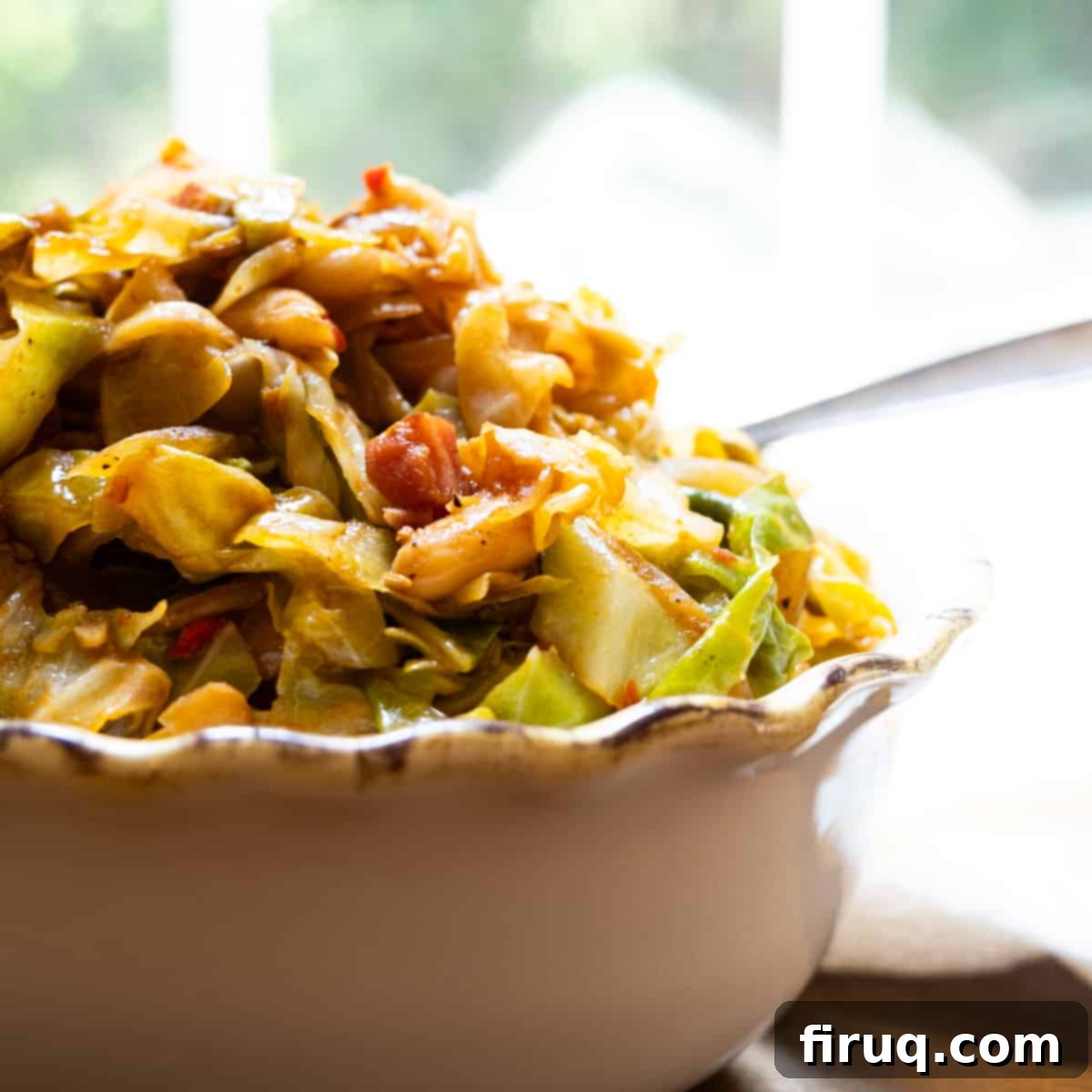The Ultimate Italian Cabbage Recipe with Crispy Pancetta & Cannellini Beans
If you’re searching for an Italian Cabbage Recipe that transcends all your previous expectations of cabbage, your quest ends here!
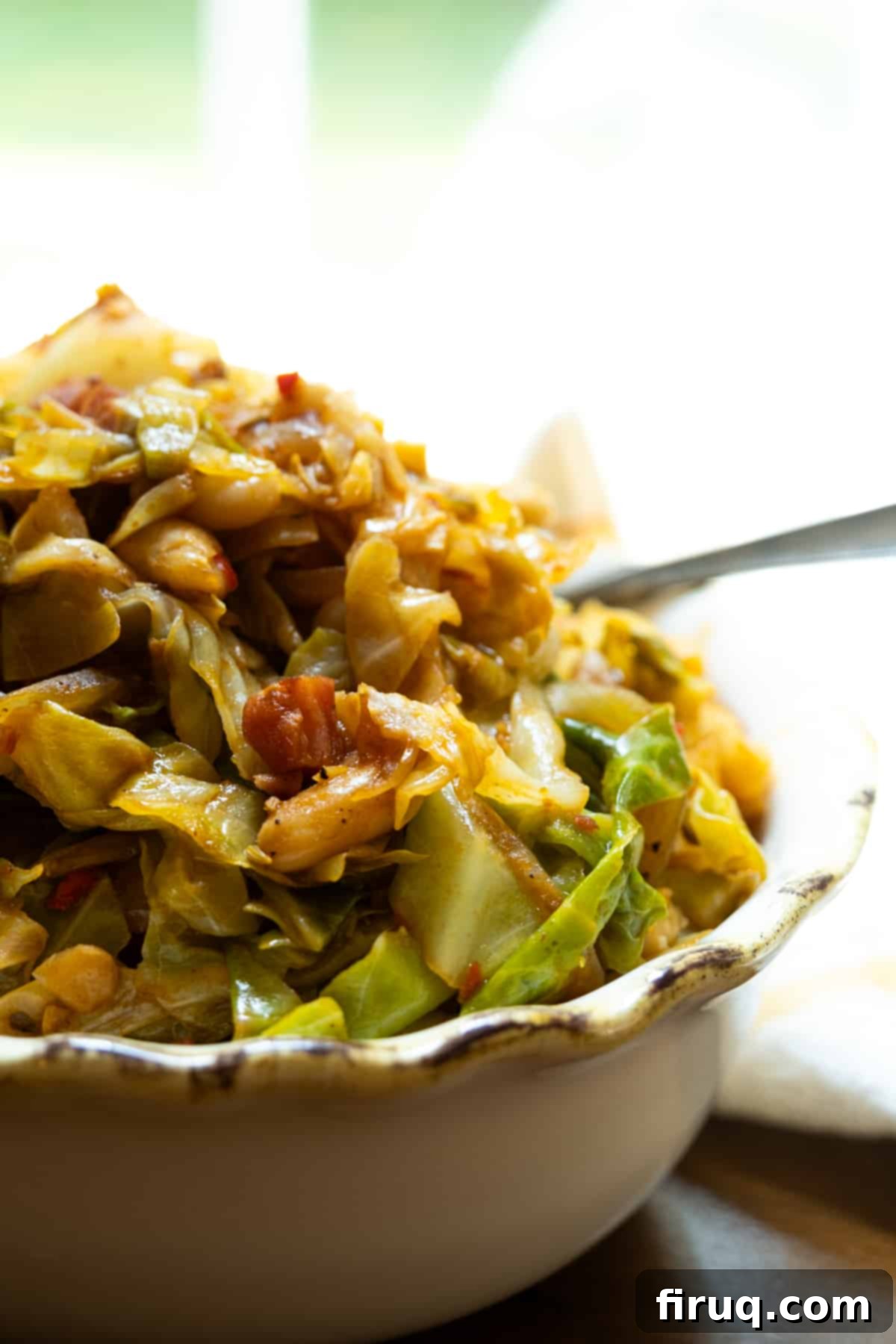
Growing up, my relationship with cabbage was, to put it mildly, contentious. It typically made an appearance once a year, usually on St. Patrick’s Day, in the form of boiled cabbage with an abundance of peppercorns. If the plain boiled cabbage wasn’t enough of a struggle, those tiny black peppercorns sealed the deal. I remember it as a chore, a culinary hurdle that only a generous dollop of butter could slightly mitigate. It certainly wasn’t something I ever looked forward to.
However, life, and apparently my taste buds, had other plans. My wife possesses this remarkable talent for transforming things I once disliked into foods I now adore. Trader Joe’s, natural peanut butter, and most surprisingly, cabbage, have all fallen under her culinary spell. She initially introduced me to a fantastic recipe from Ciao Florentina, an inspiring Italian food blogger. After enjoying that version a few times, we began to experiment, carefully refining and developing what has become our very own, deeply flavorful Italian Cabbage Recipe.
This dish has quickly become one of the most versatile and beloved offerings on our website. While it excels as a hearty side, its robust flavors and satisfying nature make it perfectly capable of standing alone as a main meal. It’s incredibly filling, packed with nutrients, and its warm, savory profile makes it a delightful addition to your table any time of the year. From crisp autumn evenings to bright summer lunches, this Italian cabbage will bring a touch of comforting Italian flair to your plate.
Why This Italian Cabbage Recipe Will Delight Your Senses
What makes this particular Italian cabbage recipe so special, especially for those who might typically shy away from this cruciferous vegetable? It’s all about the masterful blend of simple, high-quality ingredients and a cooking method that coaxes out incredible depth of flavor. Unlike bland, boiled versions, our recipe features:
- Crispy Pancetta: The savory, salty notes and irresistible crunch of rendered pancetta provide a foundational layer of flavor and texture that elevates the entire dish.
- Aromatic Base: Sweet caramelized onions and pungent garlic create a fragrant backbone, softened and enriched to perfection.
- Intense Tomato Paste: By caramelizing the tomato paste directly on the hot pan, we unlock a rich, concentrated umami flavor that adds a subtle sweetness and beautiful reddish hue.
- Warmth from Calabrian Peppers: These delightful Italian chili peppers offer a nuanced heat and a touch of fruity complexity, far more interesting than generic red pepper flakes.
- Distinct Fennel: The unique, subtle anise-like flavor of fennel is a game-changer, providing that quintessential “Italian” character and a refreshing contrast to the richness.
- Creamy Cannellini Beans: Adding a wonderful source of plant-based protein and fiber, these creamy white beans absorb all the delicious flavors and add a satisfying heartiness.
The combination of these elements transforms humble cabbage into a truly extraordinary dish that is anything but boring. It’s a testament to how traditional Italian cooking techniques can turn simple vegetables into culinary stars.
[feast_advanced_jump_to]
Ingredients
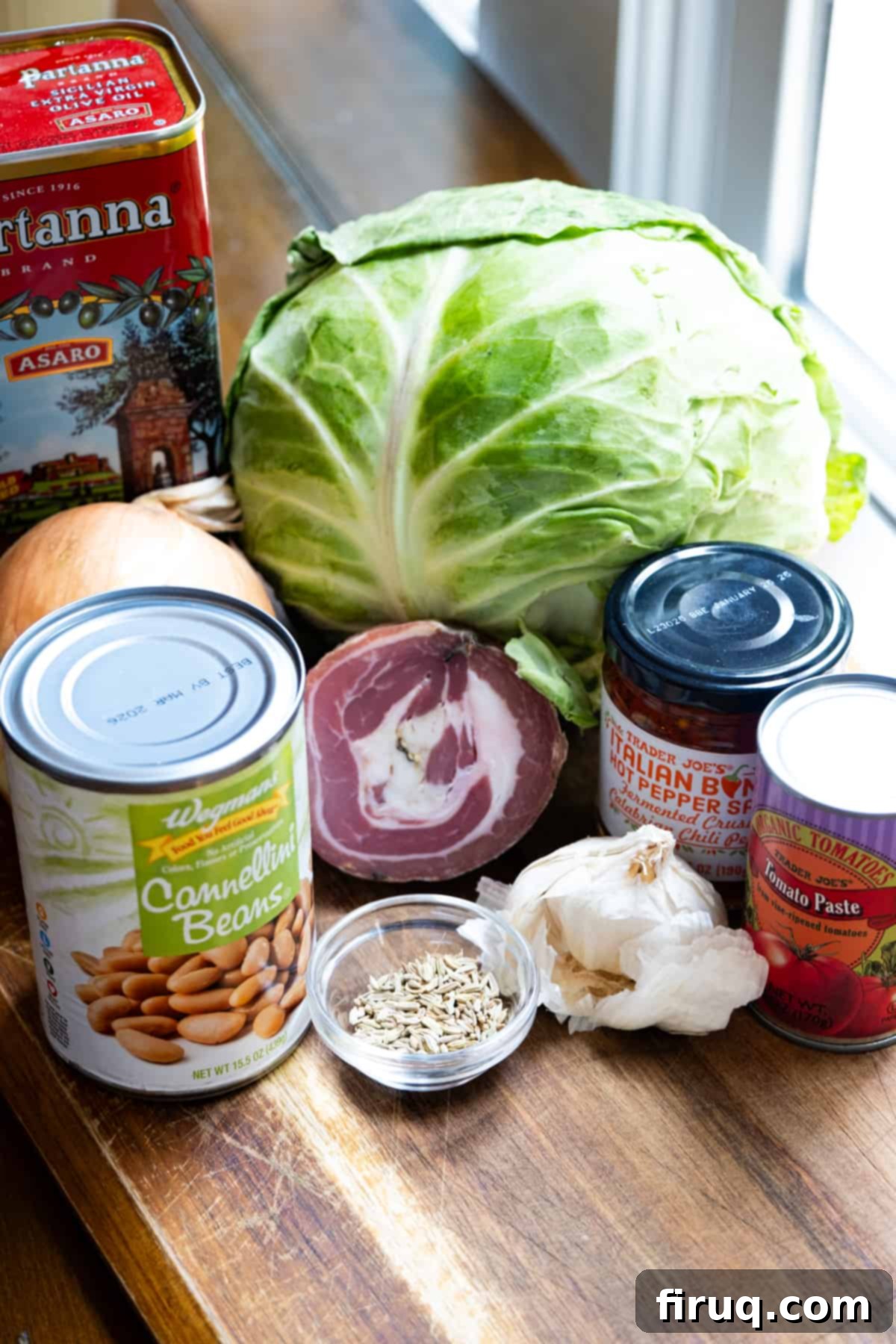
- ¼ lb pancetta, chopped
- 3 tbsp extra virgin olive oil
- 1 large onion, thinly sliced
- 3 cloves garlic, minced
- 3 tbsp tomato paste
- 2 tbsp Calabrian peppers, finely chopped (or paste)
- 2 tbsp fennel seeds, lightly crushed
- ¼ cup dry white wine
- 1 head green cabbage, halved and sliced
- Salt and freshly ground black pepper, to taste
- 1 can (15 oz) cannellini beans, drained and rinsed
Ingredient Notes and Substitutions for Perfect Italian Cabbage
Each ingredient in this recipe plays a crucial role in building its distinctive Italian flavor profile. While we always recommend using the highest quality ingredients for the best results, here are some notes and potential substitutions to guide you:
Pancetta: This Italian cured pork belly is key for its rich, savory flavor and the delicious fat it renders. I consistently choose Boar’s Head pancetta and prefer to chop it myself into small, even pieces. Pre-chopped pancetta often comes in pieces that are too small or irregular, which can affect its texture when cooked. If you can’t find pancetta, good quality thick-cut bacon can be used as a substitute, though it will impart a smokier flavor. For a vegetarian option, consider sautéing sliced mushrooms or sun-dried tomatoes to create an umami-rich base, and add a pinch of smoked paprika for depth.
Cannellini Beans: These white kidney beans are wonderfully creamy and absorb the flavors of the dish beautifully, adding substance and protein. Great Northern beans are a very good substitute due to their similar size and creamy texture. Navy beans could also work. While kidney beans are a possible alternative, they are firmer and have a stronger flavor, so adjust accordingly.
Calabrian Peppers: These provide a distinct, fruity heat and a vibrant touch that truly sets this Italian cabbage apart. They are often found jarred, preserved in oil. If Calabrian peppers are unavailable, you can substitute with crushed red pepper flakes. However, be cautious with the quantity: I suggest using 1 tablespoon of crushed red pepper for every 2 tablespoons of Calabrian peppers, as red pepper flakes tend to be hotter and lack the same fruity nuance. I once made the mistake of using both during recipe development, and it was indeed too spicy!
White Wine: A dry white wine like Pinot Grigio or Sauvignon Blanc is used for deglazing the pan, which helps lift the caramelized bits from the bottom, incorporating all that flavorful “fond” into the dish. The acidity also brightens the overall taste. If you prefer not to use alcohol, chicken broth or vegetable broth works perfectly fine as a substitute, providing moisture and depth without altering the flavor too dramatically.
Fennel: This ingredient is absolutely non-negotiable for this recipe’s authentic Italian character. Its subtle anise-like flavor is unique and integral. If you are averse to strong fennel flavor, you can reduce the amount slightly, perhaps starting with 1 tablespoon and adjusting to your taste. However, omitting it entirely would fundamentally change the dish. For an even more pronounced fennel note, consider lightly toasting whole fennel seeds before crushing them, or add a pinch of fresh, finely minced fennel fronds at the very end of cooking.
Green Cabbage: A sturdy and reliable choice, green cabbage holds its structure well while becoming tender and flavorful. Savoy cabbage is an excellent alternative; it’s generally a bit milder and has a more delicate, crinkly texture that softens beautifully. You could also experiment with Napa cabbage, but be aware that it’s much more delicate and will cook significantly faster, requiring a shorter wilting time.
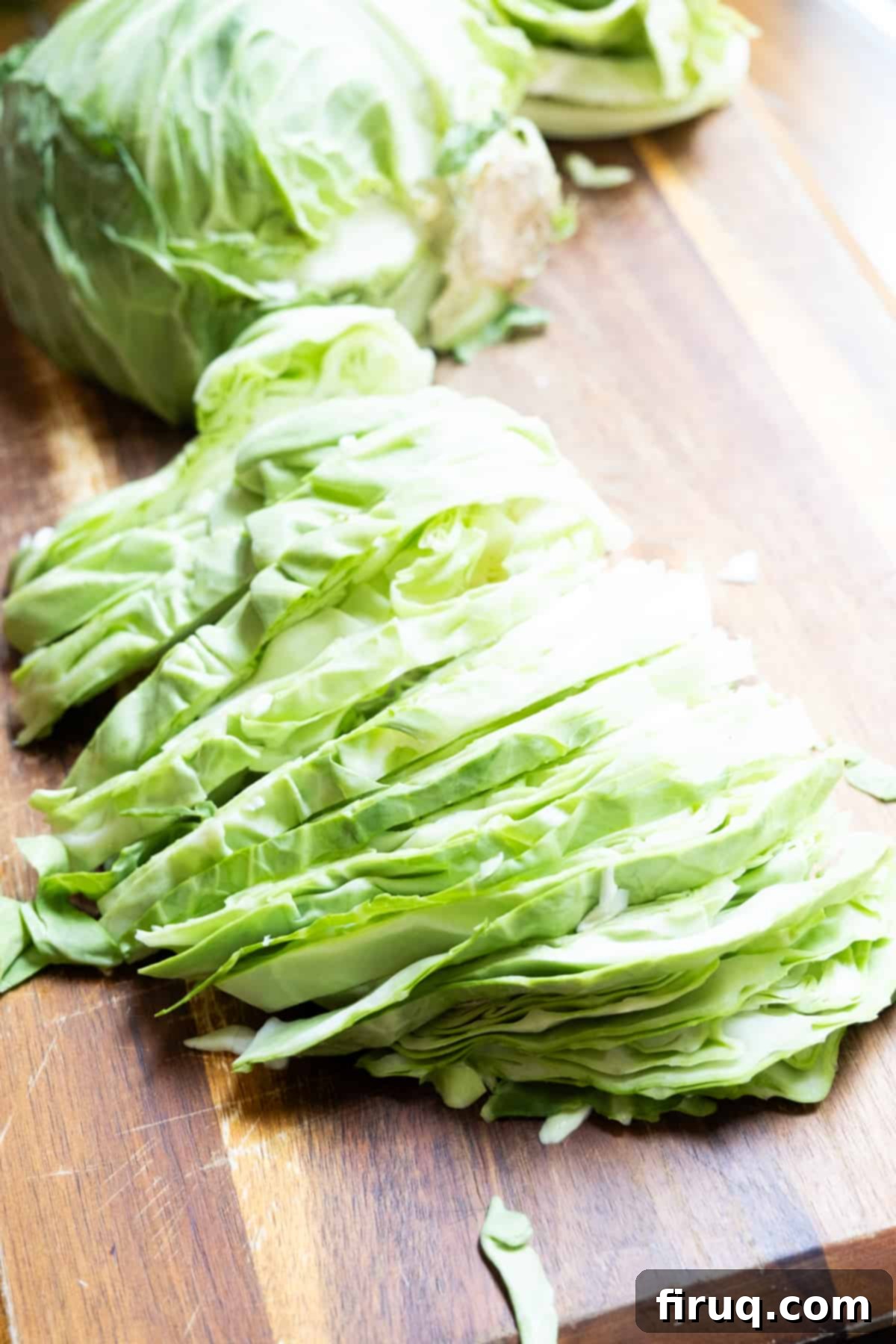
How to Make This Flavorful Italian Cabbage
This Italian cabbage recipe is deceptively simple to prepare, yet it yields profoundly delicious results. While the steps are straightforward, it does require a little patience, particularly for the cabbage to properly wilt and absorb all the incredible flavors. For optimal cooking, I highly recommend using a Dutch oven over a standard pot. Its heavy construction ensures superior heat retention and even cooking, which is crucial for building deep flavors.
For this Italian cabbage recipe, I personally used this aesthetically pleasing Dutch oven from Kana. Beyond its excellent performance in the kitchen, its design, featuring a lovely gold top handle, makes it a piece you won’t want to hide in a cabinet. It’s truly a pot beautiful enough to leave out on your stove, adding a touch of elegance to your kitchen!
1. Start with the Pancetta: Building the Flavor Foundation
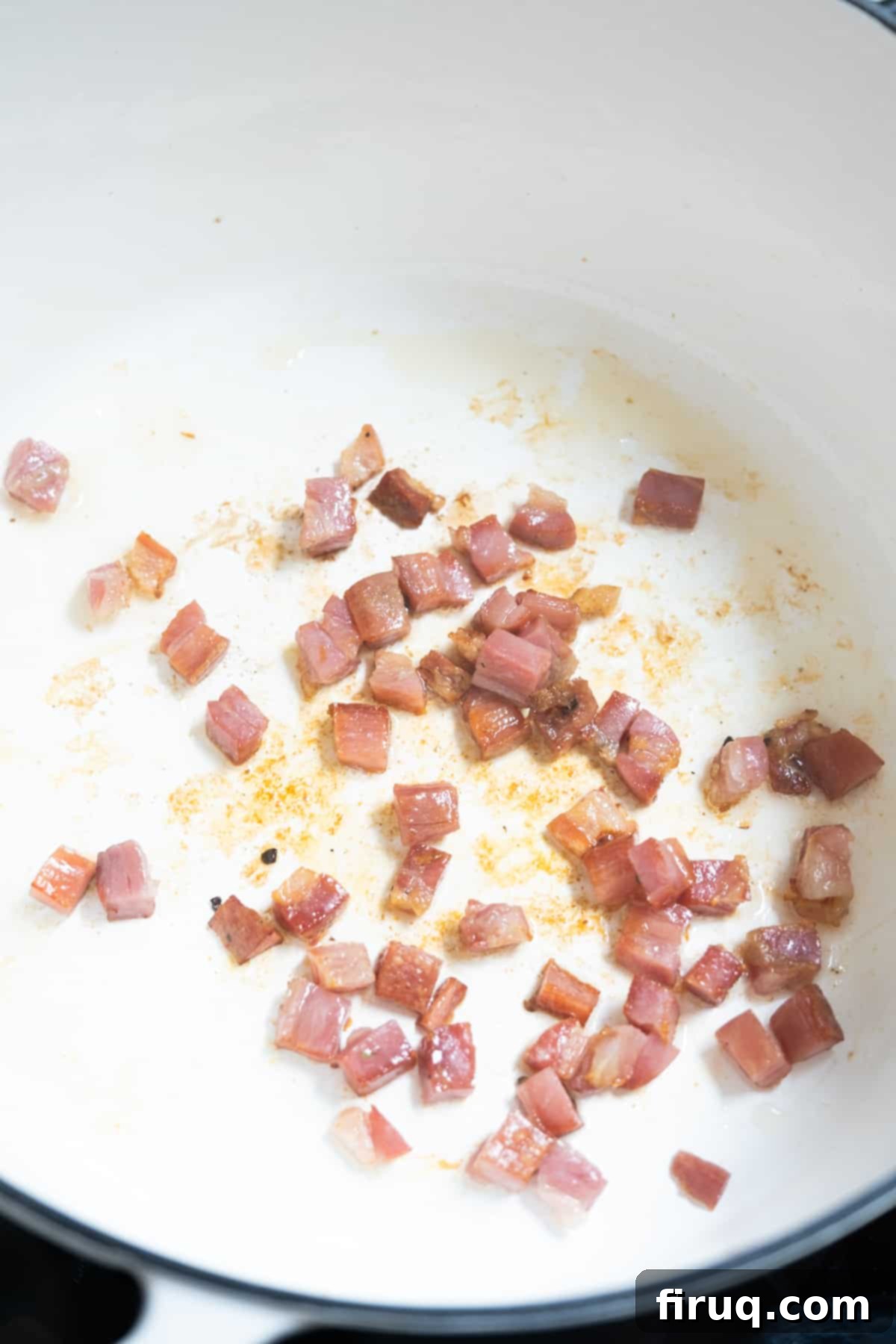
Begin by placing your chopped pancetta in a cold Dutch oven. This technique allows the fat to render slowly and evenly as the pot heats up, resulting in perfectly crispy pancetta. Raise the heat to medium and cook, stirring occasionally, until the pancetta is beautifully golden brown and crispy, typically around 8 minutes once the pan is hot. Once cooked, use a slotted spoon to remove the pancetta from the pan, transferring it to a plate lined with paper towels to drain excess fat. Set the crispy pancetta aside, reserving the rendered fat in the Dutch oven, as it will be essential for building the next layers of flavor.
2. The Aromatic Base: Onions, Garlic, Fennel & Tomato Paste
With the flavorful pancetta fat remaining in the pot, add 2 tablespoons of extra virgin olive oil. Introduce the thinly sliced onions to the pot. Resist the urge to stir them immediately. Instead, let them sit undisturbed for about 3 minutes. This crucial step allows them to develop a slight brown char on one side, a process known as the Maillard reaction, which adds incredible depth and sweetness to their flavor. This caramelization is key to a rich base.
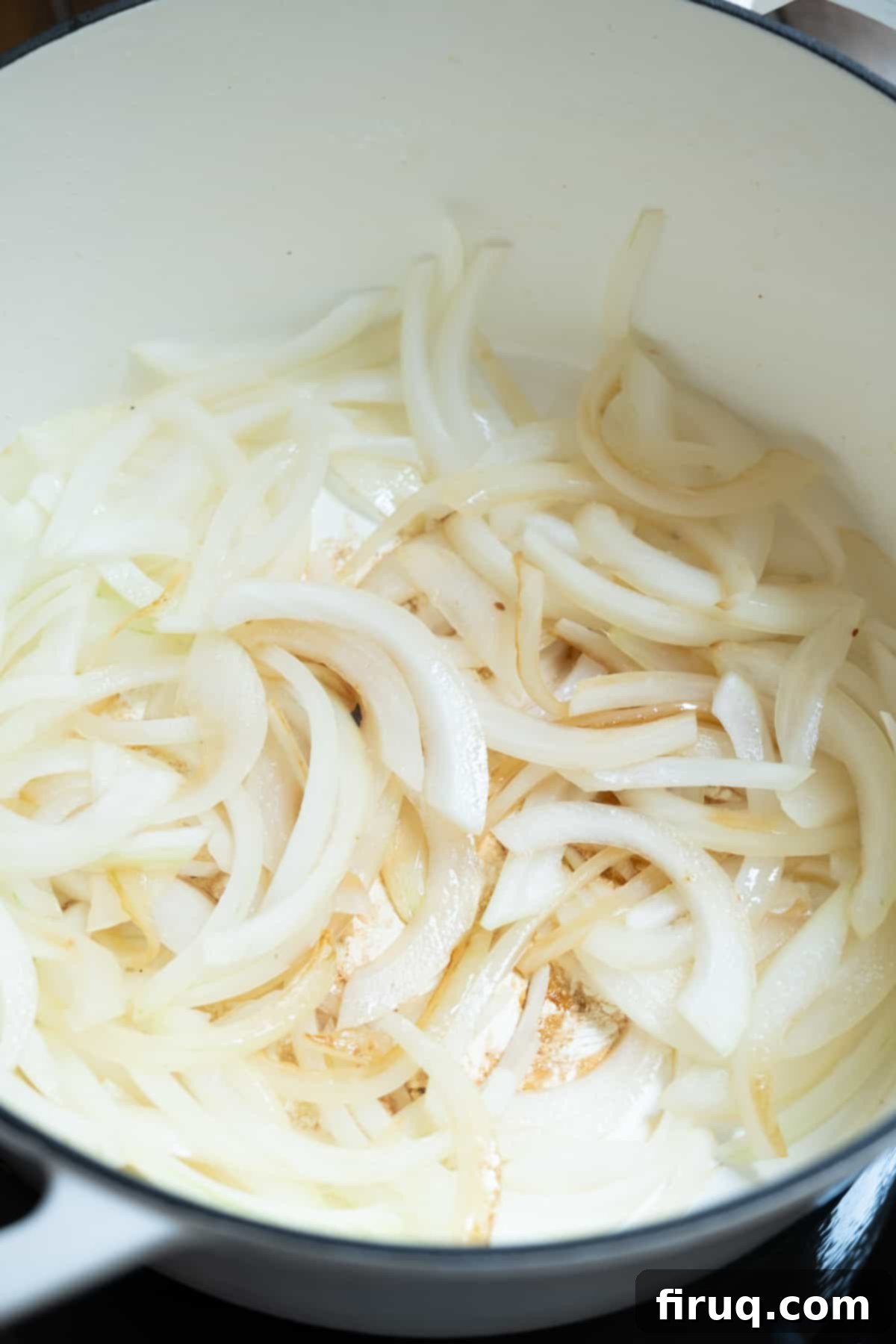
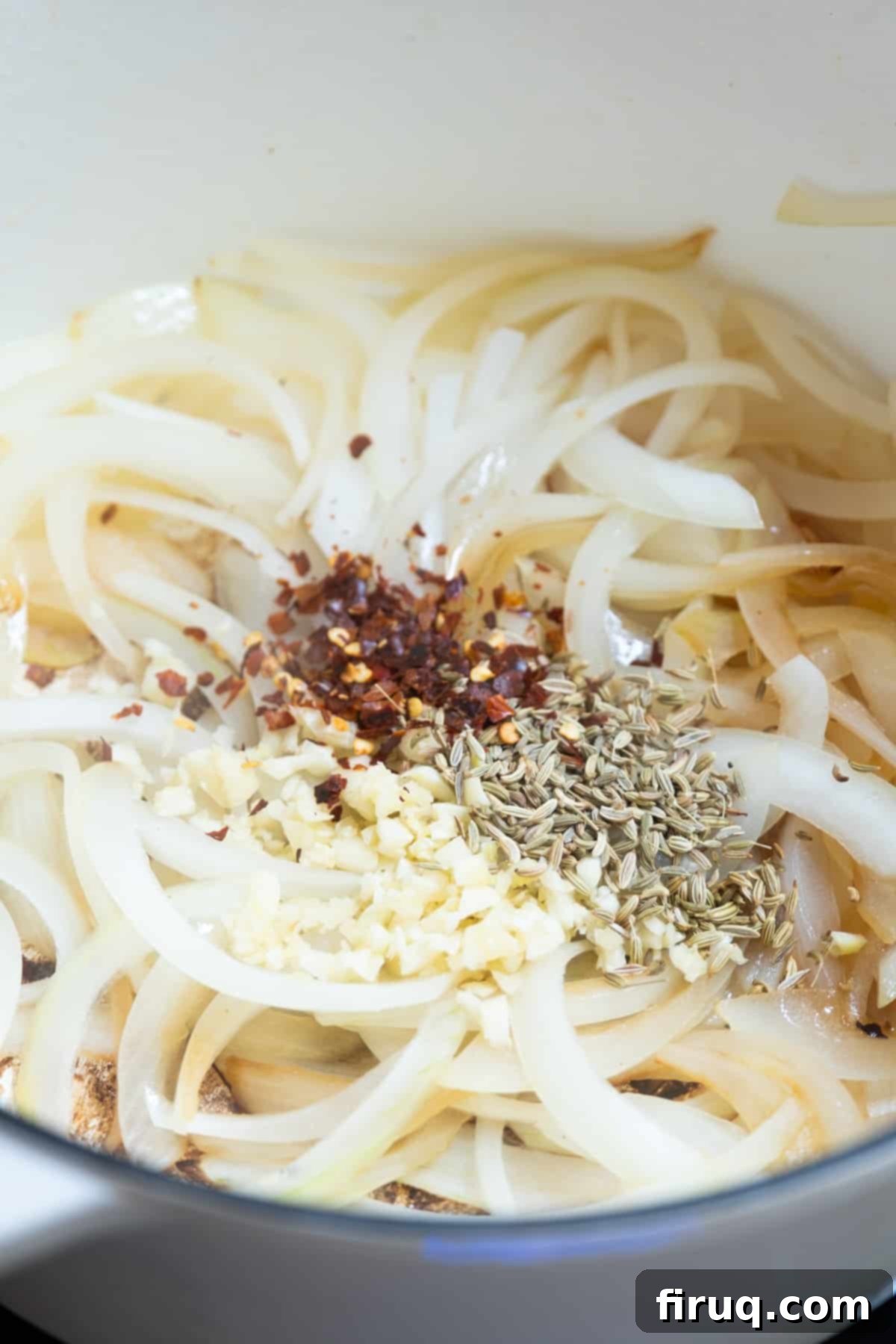
Once the onions have started to develop a lovely color, give them a good stir, then add the minced garlic and crushed fennel seeds. Sauté the garlic for just 1-2 minutes until fragrant, being careful not to burn it, as burnt garlic can turn bitter. Next, push the onion mixture aside to create a clear space on the hot surface of the Dutch oven. Place the tomato paste directly onto this hot spot, allowing it to cook undisturbed for about 2 minutes. This crucial step caramelizes the tomato paste, deepening its flavor and reducing any raw, acidic notes. After 2 minutes, stir the caramelized tomato paste thoroughly throughout the onion mixture. Finally, add the Calabrian peppers and combine everything, ensuring all the wonderful aromatics are well integrated.
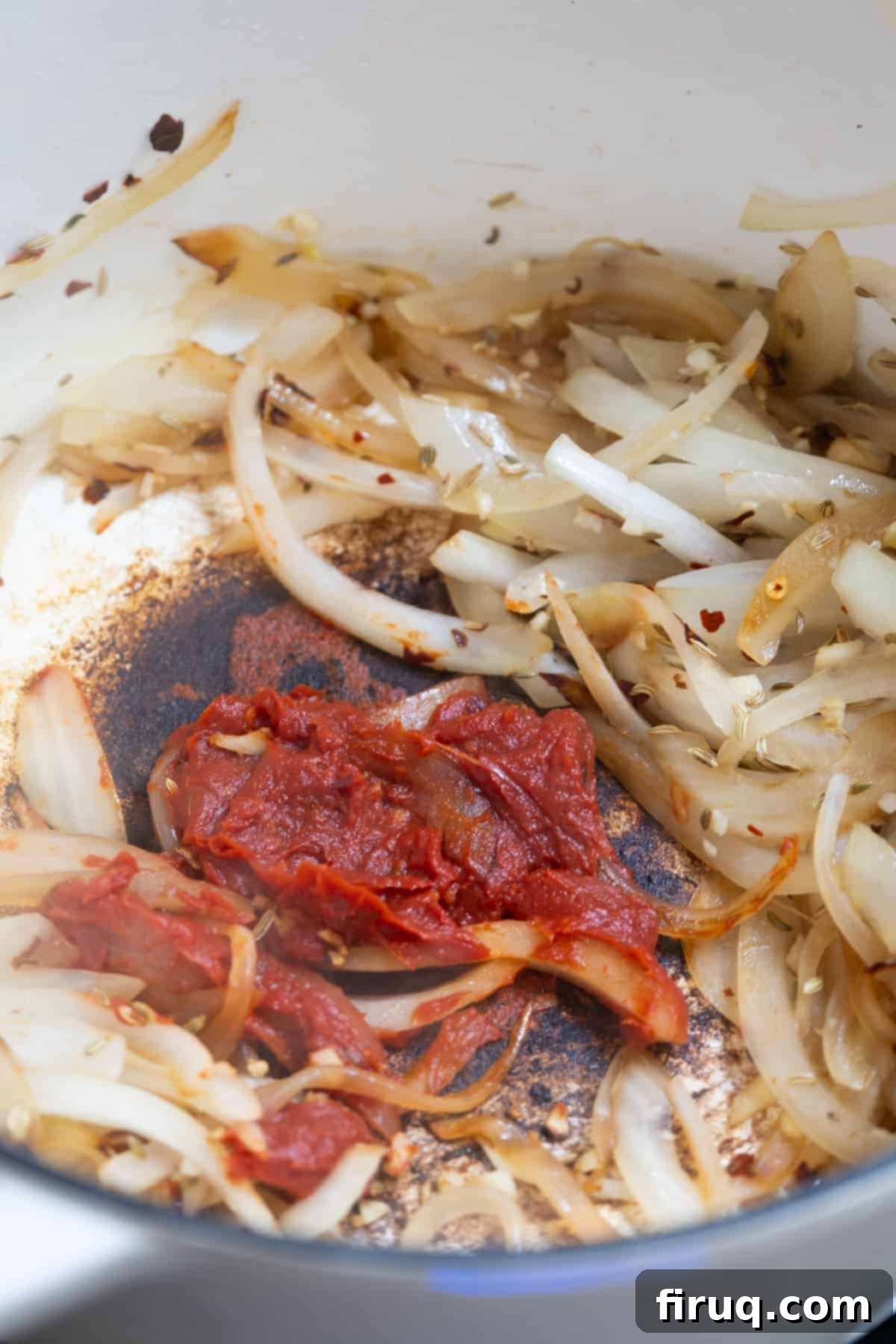
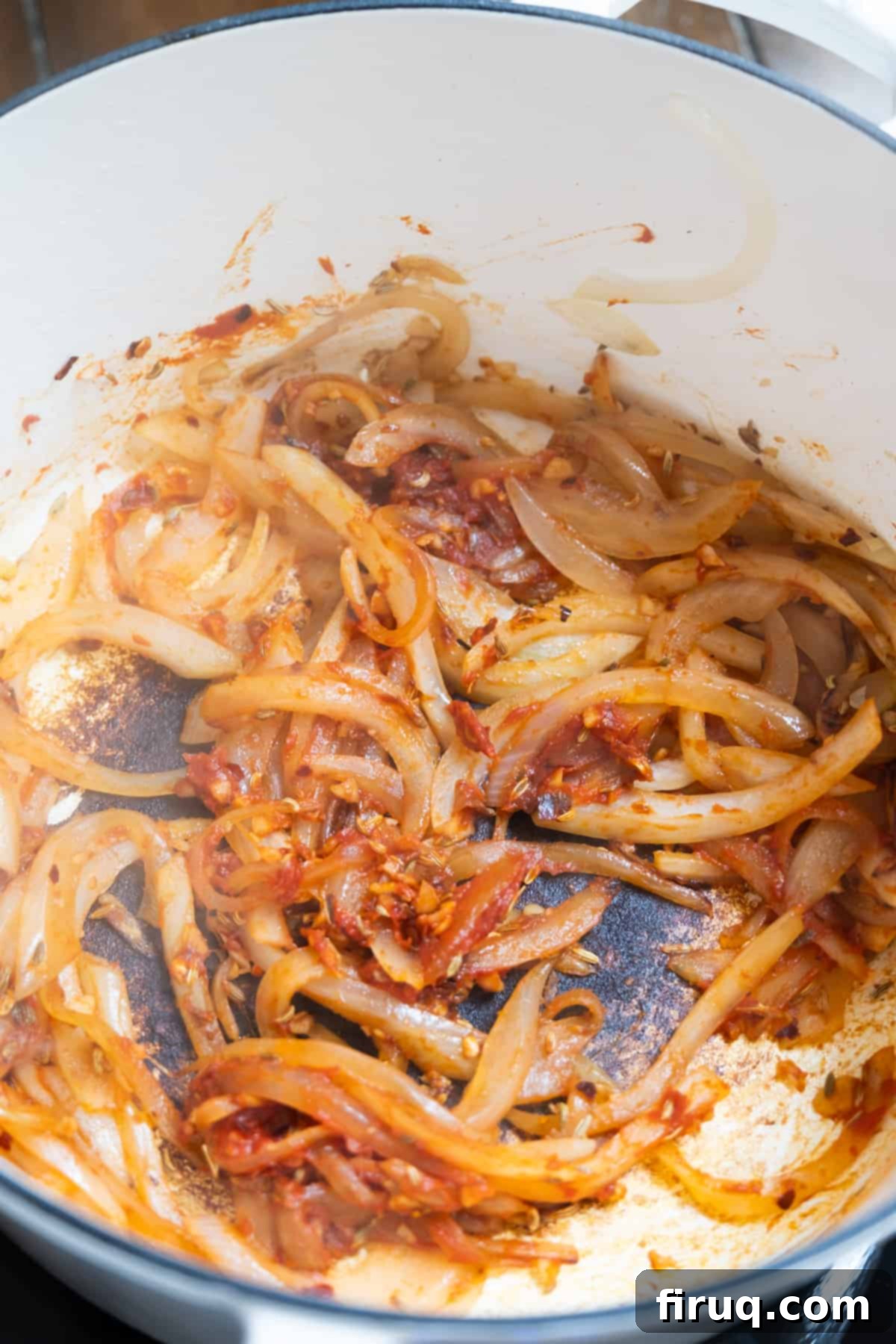
3. Deglazing the Pan and Patiently Wilting the Cabbage
Pour in the white wine (or broth) to deglaze the pan. Use a wooden spoon to scrape up any browned bits stuck to the bottom of the Dutch oven. These bits, known as ‘fond,’ are packed with flavor and will enrich your dish. Immediately after deglazing, add all the sliced cabbage to the pot. It will look like a mountain, but don’t worry, it will dramatically reduce in volume. Cover the pot tightly and let the cabbage steam for 5 minutes without opening it. This initial steaming helps soften the cabbage and jumpstarts the wilting process.
After 5 minutes, carefully remove the lid. You’ll notice the cabbage has already started to shrink. Use your wooden spoon to gently move the flavorful onion and tomato paste mixture from the bottom, incorporating it throughout the cabbage. If the bottom of the pan seems dry and there’s no liquid, add a little more white wine or water (about ¼ cup) to prevent burning. Drizzle the cabbage with the remaining tablespoon of olive oil, and season generously with salt and freshly ground black pepper. Cover the pot again for another 5 minutes.
Repeat this process of uncovering, stirring, and re-covering every 5 minutes. This consistent stirring ensures even cooking and allows the cabbage to fully absorb the rich flavors of the base. Continue until the cabbage is completely softened, tender, and has taken on a beautiful reddish hue from the tomato paste. This wilting process typically takes about 15 minutes, but sometimes it can take a little longer depending on the cabbage’s freshness and thickness. Be patient – it’s worth it for tender, flavorful cabbage!
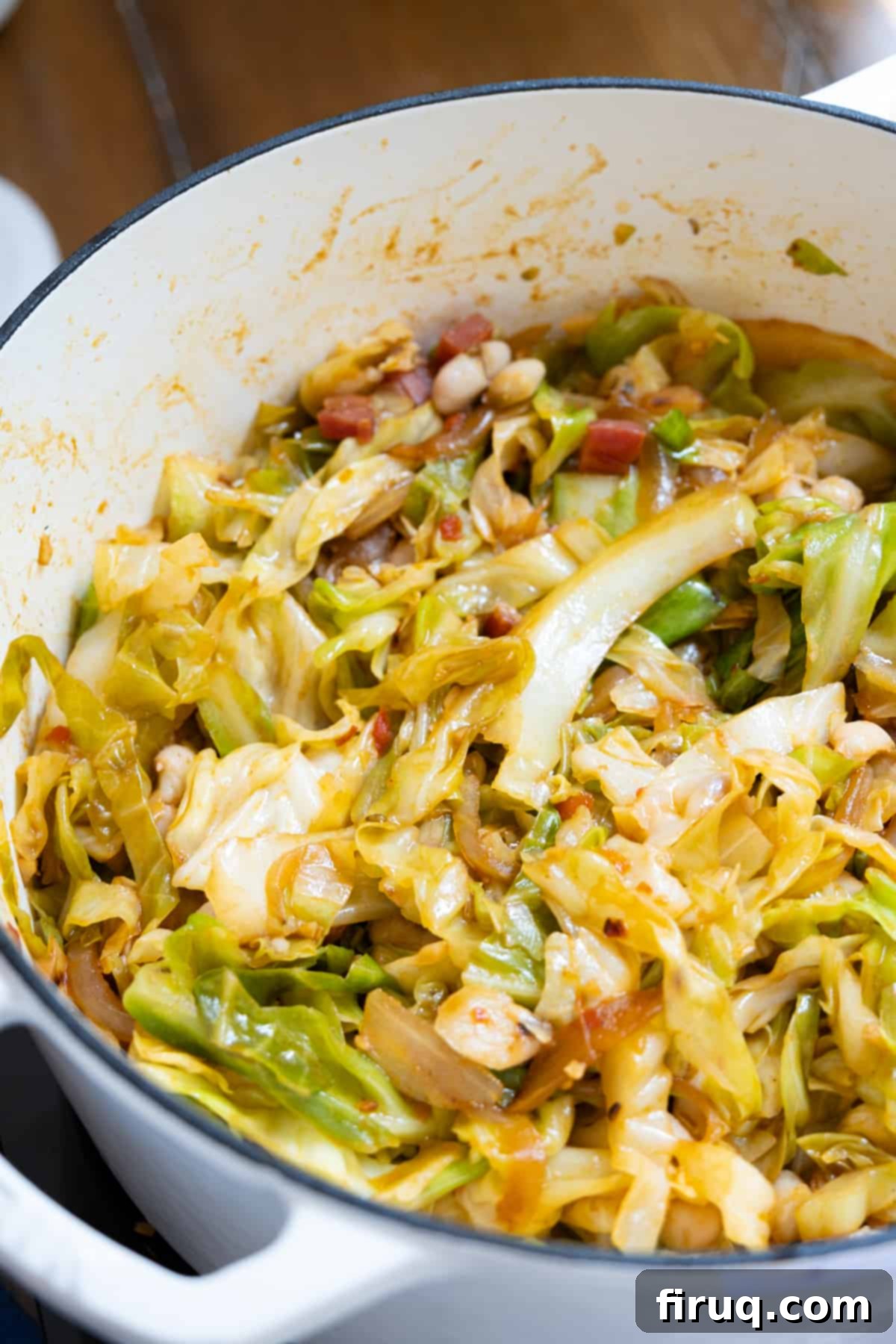
Once the cabbage has achieved that perfect tender consistency and rich color, add the drained cannellini beans to the pot. Stir them gently throughout the dish, allowing them to warm through and absorb the remaining sauce. Now, it’s time to serve this incredibly flavorful Italian Cabbage hot! Garnish with the reserved crispy pancetta for an extra layer of texture and savory goodness.
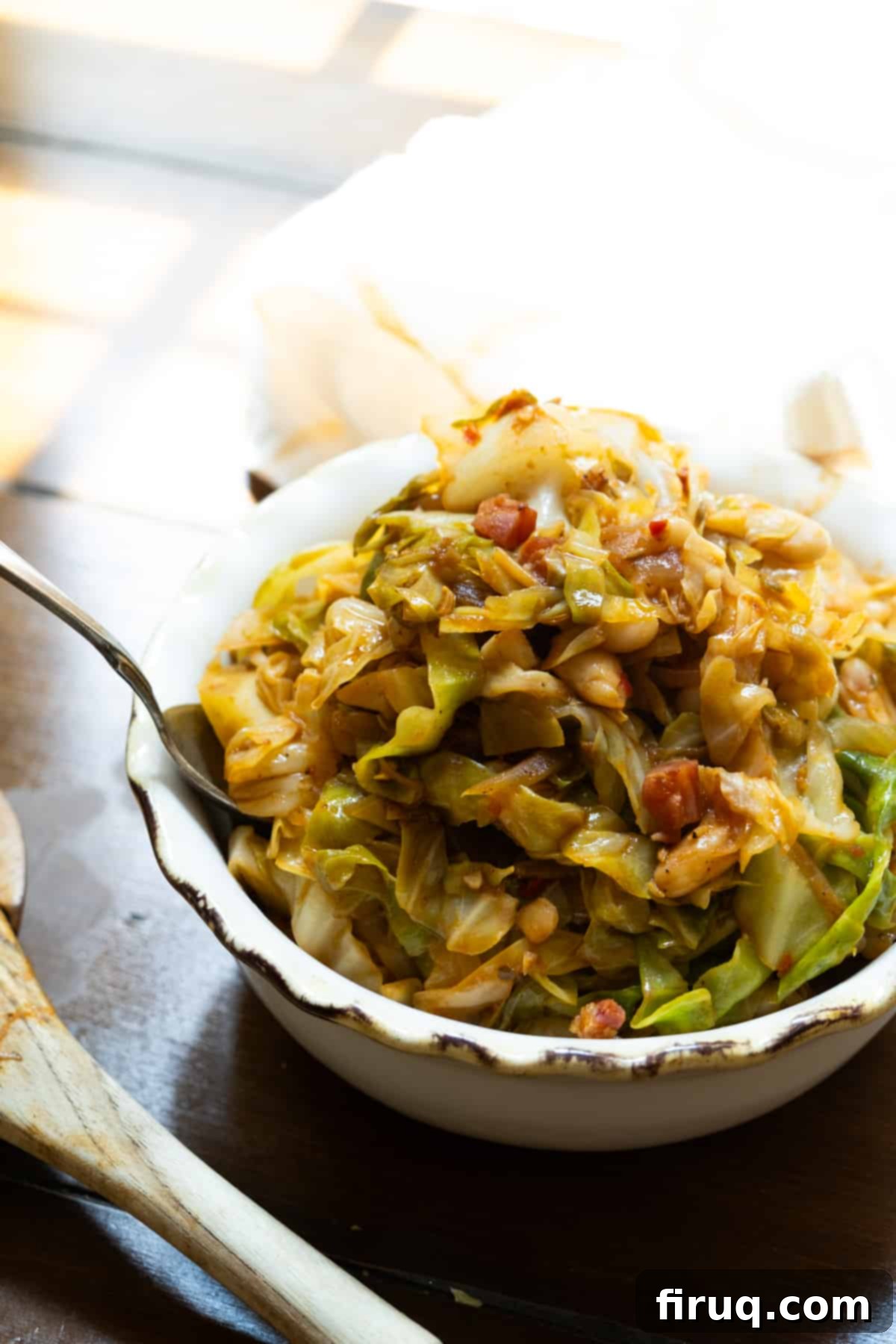
Expert Tips for the Best Italian Cabbage
To ensure your Italian Cabbage turns out perfectly every time, keep these expert tips in mind:
- Don’t Rush the Browning: Patience is paramount, especially when rendering the pancetta and charring the onions. These initial browning steps create a deep, complex flavor base that cannot be rushed.
- Caramelize the Tomato Paste: This step is critical! Cooking the tomato paste directly on the hot pan concentrates its flavor, making it sweeter and less acidic, adding a rich umami depth.
- Season in Layers: Season with salt and pepper not just at the end, but also lightly as you add the onions and cabbage. This builds flavor throughout the dish.
- Taste and Adjust: Always taste your dish before serving. You might need a final sprinkle of salt, a crack of black pepper, or even a tiny splash of red wine vinegar or lemon juice to brighten the flavors.
- Dutch Oven Advantage: As mentioned, a Dutch oven is ideal. Its heavy bottom and tight-fitting lid create a consistent cooking environment, perfect for slow braising and wilting.
- Freshness Matters: Use the freshest cabbage, onions, and garlic you can find. Fresh ingredients inherently deliver better flavor.
- Fennel Seed Freshness: For maximum impact, use whole fennel seeds and lightly crush them yourself just before adding them to the pot. This releases their aromatic oils more effectively than pre-ground fennel.
- Final Flourish: Consider a sprinkle of freshly grated Pecorino Romano or Parmesan cheese just before serving for an extra savory kick, especially if enjoying it as a main course.
Meals That Would Be Great to Serve with This Italian Cabbage
This versatile Italian Cabbage recipe makes an exceptional side dish that complements a wide array of main courses. Its robust and savory profile pairs beautifully with many Italian-inspired meals:
- Crispy Chicken Cutlets: The tender, flavorful cabbage provides a wonderful textural and flavor contrast to crispy Italian chicken cutlets.
- Classic Italian Entrees: Serve it alongside elegant dishes like Restaurant-Style Chicken Francese or a bold Spicy Chicken Saltimbocca for a complete and satisfying meal.
- Pasta Perfection: Pasta dishes always benefit from a healthy and flavorful vegetable accompaniment. This cabbage is fantastic with a simple 15-Minute Spaghetti with Garlic and Oil, a rich Creamy Red Pepper Pasta, or even to balance the richness of Spaghetti Carbonara.
- Seafood Pairings: The earthy notes of the cabbage beautifully complement delicate fish. Try it as a side for Cast Iron Lemon Dill Salmon, a perfectly Pan-Seared Snapper, or a luxurious Pistachio-Crusted Sea Bass.
- Dessert Delight: If you enjoy this dish as a full meal and still have room for dessert, consider indulging in our Pistachio Cream Tiramisu or some delightful Chewy White Chocolate Macadamia Nut Cookies.
Recipe FAQs
Savoy cabbage is characterized by its crinkled, deeply textured leaves and a generally milder, sweeter flavor profile compared to regular green cabbage. Napa cabbage, on the other hand, is an oblong-shaped, paler green variety (also known as Chinese cabbage). It has a more delicate texture and a slightly peppery, sweet taste. Due to its tenderness, Napa cabbage cooks significantly faster than both green and Savoy cabbage, so adjust cooking times if using it in this recipe.
Placing the tomato paste directly onto the hot surface of the Dutch oven allows it to caramelize quickly through the Maillard reaction. This process intensifies its natural sweetness and deepens its umami flavor, transforming it from a bright, sometimes acidic taste into a rich, concentrated tomato essence. This caramelization also helps to reduce any bitterness that raw tomato paste can sometimes impart, ensuring a smoother, more complex flavor in the final dish.
No, you don’t have to use pancetta, especially if you prefer a meat-free option. The dish is still incredibly flavorful without it. If omitting meat, you might want to start with a little more olive oil to ensure the onions caramelize properly. For a vegetarian version, consider sautéing thinly sliced mushrooms (like cremini or shiitake) until well-browned before adding the onions; they’ll add a fantastic umami depth. For a heartier, meaty flavor without pancetta, Italian sausage (sweet or spicy) is an excellent substitute or even an addition to the pancetta for an extra protein boost!
Absolutely! This Italian Cabbage Recipe is one of those rare dishes that often tastes even better the next day as the flavors have more time to meld and deepen. It’s an excellent candidate for meal prep. Store any leftovers in an airtight container in the refrigerator for up to 3-4 days. To reheat, gently warm it in a pan or Dutch oven over medium heat until it’s hot throughout. You may need to add a splash of water or broth if it appears too dry. We don’t recommend freezing this dish, as cabbage can become watery and lose its texture upon thawing.
While green cabbage and Savoy cabbage are ideal for this recipe due to their texture and mild flavor, you could experiment with red cabbage. However, red cabbage will likely impart a slightly different flavor profile and will also bleed its color into the dish, giving it a purple hue. If using red cabbage, you might also want to add a splash of apple cider vinegar or lemon juice towards the end to help set the color and add brightness, as red cabbage tends to benefit from a touch of acidity.
Other Great Side Dishes from Our Kitchen
If you’re looking to expand your repertoire of delicious and easy-to-make side dishes, here are some other fantastic options from our collection:
- Italian Lentils
- Thanksgiving Italian Sausage Stuffing
- BEST Garlic Parmesan Green Beans
- Crispy Garlic Parmesan Potatoes
If you loved this recipe and found it transformed your view of cabbage, please don’t hesitate to comment below and share your experience! We truly believe it’s a delicious and easy way to add a fantastic new vegetable side dish to your repertoire of weeknight meals. For more culinary inspiration and daily updates, be sure to follow along with us on Instagram @vindelgiudice.
📖 Recipe
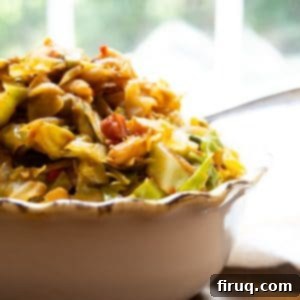
Italian Cabbage Recipe
Vincent DelGiudice
Pin Recipe
Equipment
-
1 dutch oven or large pot
Ingredients
- ¼ lb pancetta, chopped
- 3 tablespoon extra virgin olive oil
- 1 large onion, thinly sliced
- 3 cloves garlic, minced
- 3 tablespoon tomato paste
- 2 tablespoon Calabrian peppers, finely chopped (or paste)
- 2 tablespoon fennel seeds, lightly crushed
- ¼ cup dry white wine
- 1 head green cabbage, halved and sliced
- Salt and freshly ground black pepper, to taste
- 1 can cannellini beans, drained and rinsed
Instructions
-
Place the chopped pancetta in a cold Dutch oven. Raise the heat to medium and fry until golden brown and crispy, about 8 minutes once hot. Remove the pancetta with a slotted spoon and set aside, reserving the rendered fat in the pot.
-
Add 2 tablespoons of olive oil to the pot. Add the sliced onions and let them sit undisturbed for 3 minutes to develop a slight brown char. Stir, then add the minced garlic and crushed fennel seeds. Sauté for 1-2 minutes until fragrant. Create a space in the center, add the tomato paste directly to the hot surface, and let it cook for 2 minutes to caramelize. Stir thoroughly to combine with the onions, then mix in the Calabrian peppers.
-
Pour in the white wine to deglaze the pan, scraping up any browned bits. Immediately add the sliced cabbage, cover the pot, and cook for 5 minutes without opening. After 5 minutes, open and use a wooden spoon to mix the flavorful base throughout the cabbage. If dry, add a splash more wine or water. Drizzle with the last tablespoon of olive oil and season with salt and pepper. Cover for another 5 minutes. Repeat this uncovering, stirring, and re-covering process every 5 minutes until the cabbage is softened and takes on the red color from the tomato paste (about 15 minutes total).
-
Once the cabbage is softened, add the drained cannellini beans and stir gently to combine and warm through. Serve hot, garnished with the reserved crispy pancetta.
Notes
Nutrition
Tried this recipe?We’d love for you to Leave a Review!
